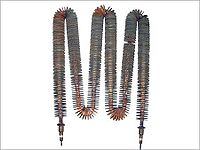Finned Heaters
Finned heaters provide a highly efficient, reliable and cost effective means of supplying heat directly to air, various types of liquids and metals.
Applications
- AC plant
- Textile machine
- Leather drying chambers
- Heating air with blowing
Construction
Nickel-chromium resistance wire is uniformly stretched and imbedded into magnesium-oxide powder. Resistance wire is accurately centered within a copper, steel or alloy sheath. Terminal pins are attached to the resistance coil at each end to create an unheated zone near the terminals.
Common Types
Finned strip heaters
Finned strip heaters, often considered component heaters, are a simple way of maximizing heat intensity and surface area to transfer heat effectively in an area. Steel fin strip heaters are an excellent heat transfer product and can be easily controlled by using either mechanical thermostat ot cost effective bimetal thermostats that can be installed on the surface of the heater. Mounting holes are useful to mount the heaters securely on the wall housing with terminal extending from the sheath for easy electrical connections. Many users also request lead wires that extend from one end that make the installation more flexible as the temperature controller is easily adaptable to this configuration.
Finned Tubular Heaters
Finned Tubular Heaters are normally used in forced circulation heating of low temperature air, other atmospheres and gases. Typical applications include forced convection heating of air, process atmospheres, and oven atmospheres in duct environments. Steel finned tubular heaters are standard with surface temperatures limited to about 425ºC (797ºF) compared to 815ºC (1500ºF) for an alloy sheathed non-finned heater.
Some applications require stainless steel materials for corrosion resistance. The most efficient finned heaters are made with steel sheath and steel fins. Steel is normally used for air heating, stainless steel for atmospheres which are humid or corrosive and monel for salt-laden humid atmospheres. Keep in mind that stainless heaters with stainless fins are very inefficient since the heat transfer rate of stainless is less than one quarter that for steel.
Video

